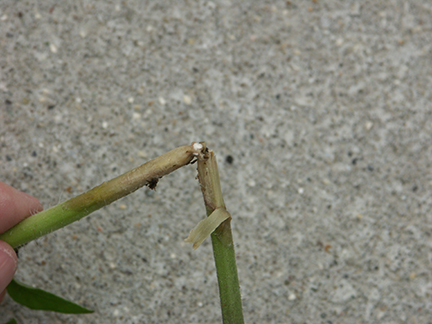In early March, I observed white mold of recently transplanted tomato plants in a greenhouse situation. I have described the symptoms, biology and management of white mold at https://ag.purdue.edu/arp/swpap/VeggieDiseasesBlog/Lists/Posts/Post.aspx?ID=18 .
I have never observed white mold (a.k.a, timber rot) in February before. I have observed white mold of tomato transplants in April. However, the very small mushroom (smaller than a dime) that is part of the life cycle usually emerges in the spring after a cold period.
The appearance of white mold in February may be as a result of the presence of the mushroom in the greenhouse that produced the transplants.
To reduce severity of white mold of tomato, I recommend that tomato growers:
- Inspect transplants for stem lesions which may be a symptom of white mold. Bring questionable symptoms to my attention or send them to the Purdue Plant and Pest Diagnostic Laboratory (http://www.ppdl.purdue.edu/ppdl/index.html).
- Clean and sanitize greenhouses in-between tomato transplant generations.
- Use a floor covering to reduce the chance of crop residue getting in the soil. A floor covering should also reduce weeds and the white mold mushrooms.
Contans is a product labeled for greenhouse use. It must be worked into the soil months before the tomato crop is planted. See the Midwest Vegetable Production Guide for Commercial Growers, 2015 (ID-56) or see the Contans label for more information.
This article was originally published at VeggieDiseases blog https://ag.purdue.edu/arp/swpap/VeggieDiseasesBlog/Lists/Posts/Post.aspx?ID=35 on March 8, 2015.
